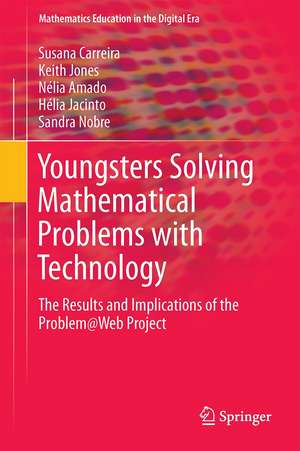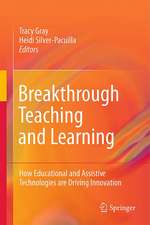Youngsters Solving Mathematical Problems with Technology: The Results and Implications of the Problem@Web Project: Mathematics Education in the Digital Era, cartea 5
Autor Susana Carreira, Keith Jones, Nélia Amado, Hélia Jacinto, Sandra Nobreen Limba Engleză Hardback – 2 mar 2016
| Toate formatele și edițiile | Preț | Express |
|---|---|---|
| Paperback (1) | 386.99 lei 6-8 săpt. | |
| Springer International Publishing – 8 apr 2018 | 386.99 lei 6-8 săpt. | |
| Hardback (1) | 394.29 lei 6-8 săpt. | |
| Springer International Publishing – 2 mar 2016 | 394.29 lei 6-8 săpt. |
Din seria Mathematics Education in the Digital Era
- 15%
 Preț: 642.68 lei
Preț: 642.68 lei - 24%
 Preț: 739.43 lei
Preț: 739.43 lei - 18%
 Preț: 782.42 lei
Preț: 782.42 lei - 15%
 Preț: 644.82 lei
Preț: 644.82 lei - 18%
 Preț: 1127.15 lei
Preț: 1127.15 lei - 18%
 Preț: 959.36 lei
Preț: 959.36 lei - 18%
 Preț: 952.26 lei
Preț: 952.26 lei - 24%
 Preț: 804.90 lei
Preț: 804.90 lei - 18%
 Preț: 990.93 lei
Preț: 990.93 lei -
 Preț: 438.10 lei
Preț: 438.10 lei - 18%
 Preț: 953.03 lei
Preț: 953.03 lei - 18%
 Preț: 889.92 lei
Preț: 889.92 lei - 24%
 Preț: 825.42 lei
Preț: 825.42 lei - 24%
 Preț: 752.34 lei
Preț: 752.34 lei -
 Preț: 360.15 lei
Preț: 360.15 lei - 15%
 Preț: 649.06 lei
Preț: 649.06 lei - 20%
 Preț: 573.76 lei
Preț: 573.76 lei -
 Preț: 389.88 lei
Preț: 389.88 lei - 15%
 Preț: 649.54 lei
Preț: 649.54 lei - 18%
 Preț: 1117.50 lei
Preț: 1117.50 lei - 18%
 Preț: 1112.78 lei
Preț: 1112.78 lei
Preț: 394.29 lei
Nou
Puncte Express: 591
Preț estimativ în valută:
75.45€ • 78.77$ • 62.44£
75.45€ • 78.77$ • 62.44£
Carte tipărită la comandă
Livrare economică 04-18 aprilie
Preluare comenzi: 021 569.72.76
Specificații
ISBN-13: 9783319249087
ISBN-10: 3319249088
Pagini: 255
Ilustrații: XVIII, 255 p. 134 illus., 123 illus. in color.
Dimensiuni: 155 x 235 x 18 mm
Greutate: 0.56 kg
Ediția:1st ed. 2016
Editura: Springer International Publishing
Colecția Springer
Seria Mathematics Education in the Digital Era
Locul publicării:Cham, Switzerland
ISBN-10: 3319249088
Pagini: 255
Ilustrații: XVIII, 255 p. 134 illus., 123 illus. in color.
Dimensiuni: 155 x 235 x 18 mm
Greutate: 0.56 kg
Ediția:1st ed. 2016
Editura: Springer International Publishing
Colecția Springer
Seria Mathematics Education in the Digital Era
Locul publicării:Cham, Switzerland
Cuprins
Foreword.- Preface.- Mathematical problem-solving with technology: an overview of the Problem@Web project.- Youngsters solving mathematical problems with technology: their experiences.- Perspectives of teachers on youngsters solving mathematical problems with technology.- Theoretical perspectives on youngsters solving mathematical problems with technology.- Digitally expressing conceptual models of geometrical invariance.- Digitally expressing algebraic thinking in quantity variation.- Youngsters solving mathematical problems with technology: findings and implications.- Afterword.
Recenzii
“I enjoyed reading the book and I enjoyed my time solving the problems also by putting myself in young students’ shoes. I can see the benefit of using these problems as well as the suggested solutions in secondary mathematics problem-solving activities. I am planning to use some of these problems (and suggested solutions)with undergraduate, graduate and teacher students as a trigger for a discussion on problem-solving also with digital environments.” (Irene Biza, Research in Mathematics Education, Vol. 19 (3), 2018)
“This book is an extensive summary/report of a three year project where schoolchildren were given problems to solve outside the usual classroom problems. … this study is invaluable in giving modern mathematical educators insights into adapting modern pedagogical techniques to reflect how young people solve problems. … all will find something that they can use to improve the effectiveness of their teaching.” (Charles Ashbacher, MAA Reviews, maa.org, May, 2016)
“This book is an extensive summary/report of a three year project where schoolchildren were given problems to solve outside the usual classroom problems. … this study is invaluable in giving modern mathematical educators insights into adapting modern pedagogical techniques to reflect how young people solve problems. … all will find something that they can use to improve the effectiveness of their teaching.” (Charles Ashbacher, MAA Reviews, maa.org, May, 2016)
Notă biografică
Susana Carreira is an associate professor in the mathematics department of the Faculty of Sciences and Technology at the University of Algarve. Keith Jones is an associate professor in the School of Education at the University of Southampton. Nélia Amado is an assistant professor in the mathematics department of the Faculty of Sciences and Technology at the University of Algarve. Hélia Jacinto is a PhD student at the research unit of the Institute of Education of the University of Lisbon & Jose Saramago Middle School. Sandra Nobre is a PhD student and mathematics teacher, associated with the research unit of the Institute of Education of the University of Lisbon & Schools group of Paula Nogueira, Olhão, Portugal.
Textul de pe ultima copertă
This book investigates problem solving approaches to mathematical problems that youngsters use in the wake of the growing availability of digital technologies, and how these approaches can be effective and productive for their unique needs. The empirical research, conducted in the Problem@Web project, delves into the many ways in which students can achieve the solution to a mathematical problem and communicate it with the technological tools they have at their disposal, either in their home environment or in their mathematics classroom. The researchers then address the implications for the future study of a broadened perspective on mathematical problem solving with technology. In addition to exploring how technology has changed mathematical problem solving, the book also provides:
Youngsters Solving Mathematical Problems with Technology is an extremely valuable resource for any researcher or educator interested in mat- A well-developed theoretical framework that integrates the use of technology into mathematical problem-solving
- Insightful analysis of the young participants’ methods of mathematical problem solving, in addition to their teachers and families
- Examples of student solutions, together with the students’ explanations of how they achieved their solution
hematics education, technology in education, or the intersection of both.>
Caracteristici
Addresses existing deficiencies in knowledge about mathematical problem solving, like the limited knowledge of students' mathematical problem solving skills outside of the classroom Reports on the unique needs of "digital native" mathematics learners Explores students' and teachers' perspectives on mathematics learnings, especially comparing classroom learning to out-of-the-classroom learning Includes supplementary material: sn.pub/extras



